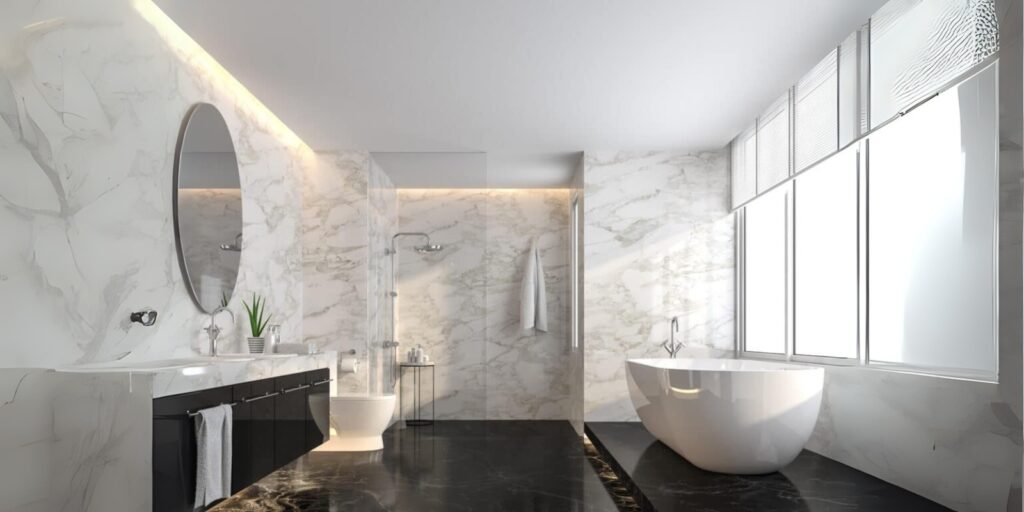A bathroom remodel is one of the most satisfying and exciting home renovation projects to take on. These are spaces we use every day, and that our guests frequent. A bathroom’s design is an expression of your personality and style. From fixtures to final configurations, there are many important decisions to make in a bathroom remodel, but perhaps the one with the most impact is tile. The right tile choice will bring the whole design together, and enhance your bathroom’s utility and appearance. When considering which tile is right for you and your bathroom design, you’ll quickly find that there are nearly unlimited choices in tile size, material, color, and finish. In this post, we identify and break down the most important things to consider when it comes to tile as you begin your bathroom renovation project.
1. Emphasize Functionality:
Bathrooms are commonly exposed to moisture, humidity, and frequent use; therefore, when designing your space, keep functionality at the front of your mind.
- Bathroom flooring initially should be slip-resistant to minimize fall accidents.
- Matte-finish glazed tile, or tile with a textured finish, are safest for flooring.
- Wall tile can be glossier or slicker, as this surface will typically be the cleanest and will leave you with the least amount of cleaning time.
- Shower tile should be moisture-resistant, along with being resistant to stains and cracking for longevity.
Keeping functionality in mind as you make your tile selections helps to narrow your choices and ensure a safe space.
2. Choose the Appropriate Material:
Tile materials vary; each having its pros and cons:
Ceramic Tiles: These are more inexpensive, reliable, and available in a wide variety of styles and designs. Ceramic tiles work well on walls or are a great choice for low-traffic, dry areas on the floor.
Porcelain Tiles: Porcelain is denser, with low water absorption (< 0.5%); it has a stronger glaze surface and is more durable than ceramic. Porcelain also works well with water for floors and is a higher quality material.
3. Choose Colors That Set the Mood:
Color is one of the most important factors in establishing the atmosphere in your bathroom:
- Light colors (white, beige, light brown) are always a classic choice. These can also give smaller spaces the illusion of being larger than they are.
- Boulder colors (Navy, Emerald Green, Black) create an ambience of moody sophistication.
- Neutrals are timeless and create a comfortable combination with any design style.
Pinterest is a great resource for design inspiration. If you are not confident, use a neutral color for a base and add color through accessories; remember that once installed, accessories are easier to change than tile.
4. Remember Grout Choice:
Grout is often an afterthought but it can totally change the look and feel of your tile selection.
Grout that matches the tile is always a safe bet, and ties the look together seamlessly.
Grout that contrasts the tile will help draw attention to the tile shape and pattern.
Epoxy grout is more durable and resistant to staining than cement grout.
The selection of good grout will also affect maintenance. The lighter the grout, the easier it will stain, while darker grout can hide stains and wear over time.
5. Plan your budget wisely:
Tile price varies widely, from the budget-friendly ceramic to the premium natural stones.
- Allocate more budget to high-use areas (eg , floor and rainfall).
- Save on costs by using luxury tiles as accents and pair them with affordable base tiles (think accessorizing the tile niche).
- Always order 10–15% additional tiles for initial install, accidents in install, and future repair.
6. Take Tile Size and Layout into Account:
Tile size can really impact the overall feel of your bathroom.
Small tile selections can give a sense of intricate detail both to small and large bathrooms, while large tiles create a sense of spacious grandeur.
When looking to add textural detail to a shower floor or a wall, small mosaic tiles are a fantastic choice.
Medium sized tiles like subway tiles are a great balance between slightly more formal spaces, and contemporary, casual spaces.
Note that the layout patterns—a herringbone, stacked, or diagonal orientation can keep it interesting without any extra cost.
7. Try Samples Before You Commit:
Photos and showroom displays don’t always show how tiles will really look in your home.
- Take the samples home and look at them under the lighting of your bathroom, test them next to your paint colors, fixtures, and overall style.
- If you are choosing floor tiles, walk on them to check slip resistance and comfort.
- Thoroughly testing your tile choices will help to ensure that you don’t not lose sleep over your decision after selection and install.
8. Balance style and practicality:
The shiny finish looks elegant, but may be slippery when wet.
Matt or textured tiles are safer for floors and add heat.
Pattern tiles are stylish, but can be dated; make these choices carefully and with the entire design in mind, considering how the space will age with design trends over time.
A great overall goal and guide is to balance long-term practicality with your own personal style.
Final Thoughts:
When choosing tiles for your bathroom renovation, balance aesthetics and style with the overall project design. Make your selection with a balance of design, durability, safety, and cost. Looking at your decision through this lens will enable you to create a space that reflects your style while ensuring safety and longevity.

